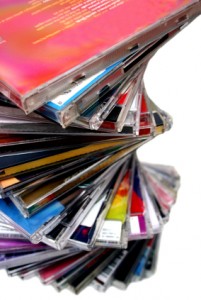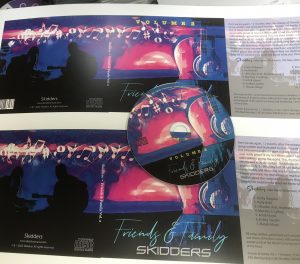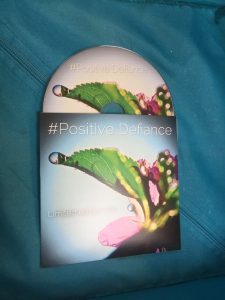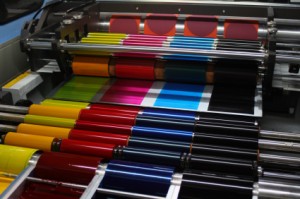
It's tricky to create a good CD design - so here are some tips to help you!
The design of your CD artwork will have a really massive effect on who buys it and what your consumers think of it. Way before they listen to your CD, they will probably see the cover on a shop shelf. A lot depends on them taking an initial liking to this image, and also to the insert or booklet and back cover. This is why it is so important to put lots of effort into making your CD artwork look appealing and attractive – and not just to any user, but to your selected market! So this article intends to gives some helpful tips and advice on how to make your CD look super!
To start, it helps to know what size your inserts need to be:
– The insert for the front is 4.75”x4.75”
– If you want to make a foldout, simply add an extra 4.75” of length onto the initial dimensions for the insert until you have the desired number of pages
– If you are making a booklet, it should be 9.5”x4.75” so that it can be folded in half. This can be repeated for as many pages as are needed in the booklet
– The back insert is 5.906” with 0.25” on either side for each spine x 4.625”
These are the standard sizes for a CD Jewel case however I would advise leaving a 0.25” ‘bleed’ around everything to make sure that you don’t get any nasty unintentional borders – these can look really unprofessional! A ‘bleed’ is a gap where the image overlaps outside the print area and it serves to prevent white patches around the edge of an image. Similarly, don’t forget to leave a 0.25” gap inside the image too, called a ‘safety’, making an area called the ‘live’ image, where you can be certain that no important bits will get chopped off!
As for what you put in the artwork, that is quite up to you, but it is a good idea to have important information accessible from the outside, i.e. on the front or back covers. For example, if you are making a music CD, it is a good idea to include the artist, album or single title, song names and record label in an easily visible place. But at the same time, don’t overload the cover with information which could be off-putting to many users. Sometimes simple is good! If you are making a booklet, you might want to put in some interesting information like an interview with the artist, lyrics or acknowledgments. Conversely, you could just have lots of really lovely pictures – it depends a lot on what you want the mood of the CD to be.
As for the imagery itself, try and make it as personal as you can, for instance if you’re making a mix CD for a friend perhaps include images of the two of you together! Obviously, if you are aiming at a wider audience try and define what would appeal to your market. For example, heavy metal music usually has very heavy, gothic artwork involving lots of blood, skulls and demons, while classical music tends to have calming scenery or renaissance paintings on the cover.
The same rules apply for choosing a font. For a more serious audience, try and select a serious font, for instance ‘Garmond’. Try not to pick anything that is too hard to read or very over-used – these will both put people picking up your product whether because they can’t understand it or whether because they dislike the cliche implied!
To pick up the mood of your CD, especially if it’s musical, it can be really beneficial to listen to it while you are working on the artwork: Professional graphic designers do it all the time to get their creative juices flowing! Also, try creating a few different images before you settle on one as sometimes the first idea you have is not necessarily the best and look at other artwork to see what else is being done for inspiration. If you’re working on a computer, it is also worthwhile to zoom right out sometimes and take a look at the cover as a whole: This will give you a much better idea of what it will look like once it’s printed up!
Be especially careful when designing your spine – it may look like a small thing but it is very easy to mess up if you don’t leave the proper bleeds either side of it! I would suggest at least two millimetres to compensate for any inaccuracy during the guillotining process, ensuring the writing doesn’t get cut in half or left off altogether! It’s usually a good idea to fit as much information as you can on here. With a music CD it’s normally the band name, record label and album or single title.
It’s also quite important to keep your packaging in mind: The artwork will have to fit into it. Consider whether you wish to make a booklet, fold-out, single sleeve or whether you want to do something extra special. The band Tool recently brought out a very individual album with stereoscopic viewing lenses inside the booklet which made all the images appear in 3D! Their fans loved it and it got them a lot of publicity! Remember though, when brainstorming these awesome ideas, to always consider the cost, too. Sometimes what seems like a great plan is not practically the best thing to do.
It’s also worth bearing in mind – and this is particularly appropriate for music CDs – that in this technological age, many CDs get copied to computer CD libraries where the CD artwork can be viewed when the song is played. It is worth remembering that any special colours, or ‘spot’ colours, which cannot be made with the standard computer colour displays will not show up! These include fluorescent and metallic colours. Though these look very nice on the shelf, you may want to make a different set of artwork that is computer-friendly, too.
A particularly useful website for helping to design and create original and attractive CD covers, inserts and body-prints is offered here for free! You can upload your own images, add text and know for sure that your layout is exactly what is needed!
I hope this helps get your ideas-hat on and gives some practical advice, too! Good luck with all your CD artwork designing! Remember to keep your intended user in mind and never stray far from the CD content and you’ll be well on your way to creating some great CD artwork!





